“BOYD’S GENUINE PORCELAIN LINED CAP” This marking is one of many slight variations in phrasing embossed on circular milk glass liners (“caps”, “inserts” or “discs”) – part of zinc screw-type lids used with the Mason (screw-threaded) style fruit jars.
The glass liners helped prevent food from coming in direct contact with the metal lid, which otherwise would have caused a metallic “off-taste” imparted to preserved food (not to mention the increased possibility of contamination from bacteria).
ADVERTISEMENT
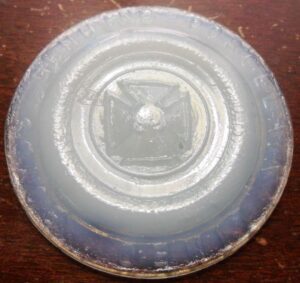
Lewis R. Boyd was issued a patent for his invention (patent #88,439) on March 30, 1869. The actual title of the patent is termed “Improved Mode of Preventing Corrosion In Metallic Caps”.
The patent can be viewed here, a .pdf file from the sha.org site : Boyd’s Patent of March 30, 1869.
Tremendous numbers of these glass discs were made, by a number of glass companies, many of whom are as yet unidentified. Some of the earlier examples may have been produced by Consolidated Fruit Jar Company, and/or Hero Fruit Jar Company.
ADVERTISEMENT
Hazel-Atlas Glass Company (after 1902) is known to have produced large quantities of the inserts. A photo of one of these is shown below.
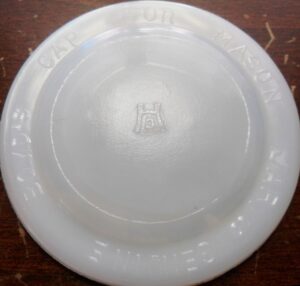
Although most of them are found in an opaque, or semi-translucent white milk glass, some are seen in “off” shades of milky or “foggy” aqua, green or blue. Only a very few of them were actually made of true porcelain, the great majority being made of glass, notwithstanding the phrase which would indicate otherwise.

It is difficult if not impossible to assigned specific years of production to any of these liners. Presumably, the first ones date from approximately 1869. The very earliest versions are said to have been made in transparent glass, with milk glass versions introduced approximately 1871. It is assumed that most of the earlier versions of these liners have the name “BOYD’S” or “BOYD” embossed on them. Later versions may or may not have the name included in the lettering.
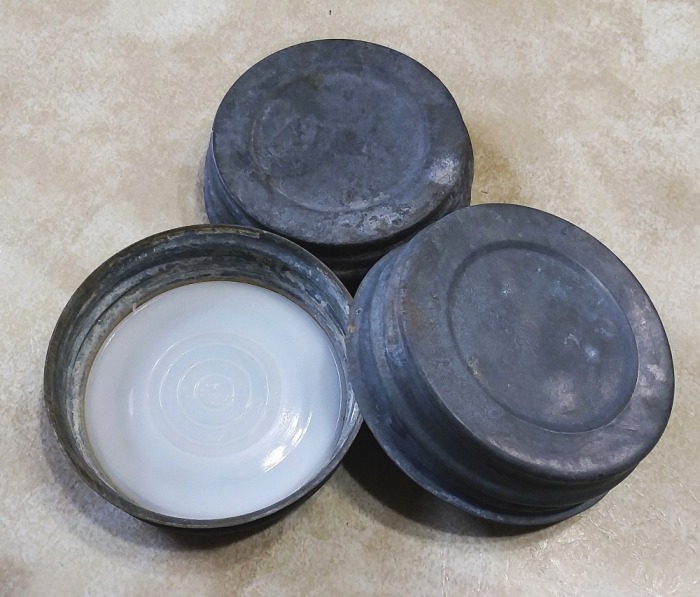
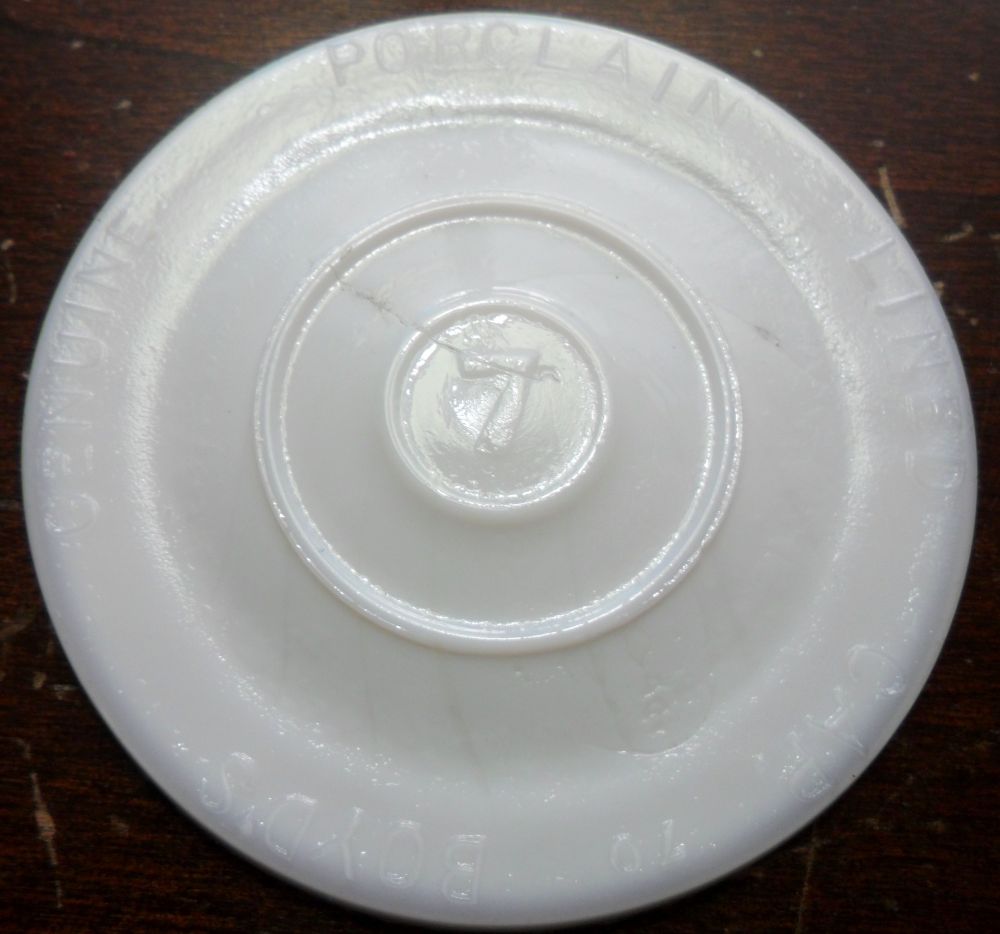
The glass liners were continued to be made in huge quantities for many decades thereafter, with production probably extending well into the 1950s or later. The timeline of markings (which ones came first) is uncertain. Many of the metal zinc lids marked “BALL” (in cursive) come with an insert marked “Genuine Zinc Cap for Ball Mason Jars” (no mention of Boyd). Those were made for fruit jars manufactured by Ball Bros. Glass Manufacturing Company.
According to some information presented by “Joe” in this website discussion thread – about Ball jar closures and inserts, the discs marked “Genuine Zinc Cap for Ball Mason Jars” may date from the 1920s, 1930s and 1940s: Ball Zinc Jar Lids Discussion
Some discs are found with spelling errors, as the two shown on this page. One includes the word “PORCELAIN” misspelled “PORELAIN” ; another one is marked “PORCLAIN”. There are probably other error spellings out there to be discovered! I didn’t notice these errors until looking very carefully with a magnifying glass!
The liners are frequently found by bottle diggers at old dump sites, or in privies (where outhouses used to stand) along with other durable (non-degradable) items such as bottles, jars, broken dishes, pottery sherds, porcelain casters/wheels, shards of glass tableware, coins, marbles, toys, metal objects and other artifacts. They are often found separated from the zinc lids they were originally attached to.
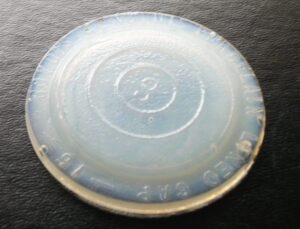
Many slight variations in the exact lettering are seen. Some of the lids carry mold numbers, such as “2” or “3”. The mold numbers, especially on older inserts, are often hand-engraved and rather crude-looking.
Here are some of the lettering variations recorded (there are surely many other variants that exist besides these!)
1) Boyd’s Genuine Porcelain Lined Cap [There may or may not be a mold number, such as 1, 2, 3, 7, 9, 13, etc, embossed in the center, or along the rim]
2) Genuine Boyd Cap / For Mason Jars
3) [Diamond logo] Genuine Zinc Cap [Diamond Logo] For Ball Mason Jars
4) Genuine Porcelain Lined Mason Cap
5) [Hazel-Atlas mark in center] Genuine Boyd’s Cap / For Mason Jar / [mold number]
6) [M inside a diamond mark in center] Boyd’s Genuine Porcelain Lined
7) Maltese Cross logo [with letters H F J Co , placed inside the four “arms” in center] – along with the words “Boyd’s Genuine Porcelain Lined”, this type used with lids made for the Hero Fruit Jar Company jars.
8) Maltese Cross logo (in center) with letters in “arms” as above, and the words “THE HERO FRUIT JAR COMPANY / PHILA. PA.” in circular formation around the rim (shown below).
9) Unmarked – No numbers or letters.
10) No lettering, except for 3 concentric raised lines (rings) and a mold number in center. Mold numbers may be two digits such as “33” or “64”. I am sure there are many other numbers out there! I’ve seen these discs inside zinc lids marked with the “BALL in cursive” logo on top of the lid.
11) Mold number only, no concentric rings, no other markings.
12) Consolidated Fruit Jar Company – New York (C F J Co monogram in center)
13) Boyd’s Genuine Porclain Lined Cap – [Number] (note “Porclain” misspelling)
14) Boyd’s Genuine Porelain Lined Cap – [small sideways number/larger Number/small sideways number] (note “Porelain” misspelling)
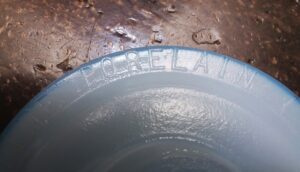
ADVERTISEMENT
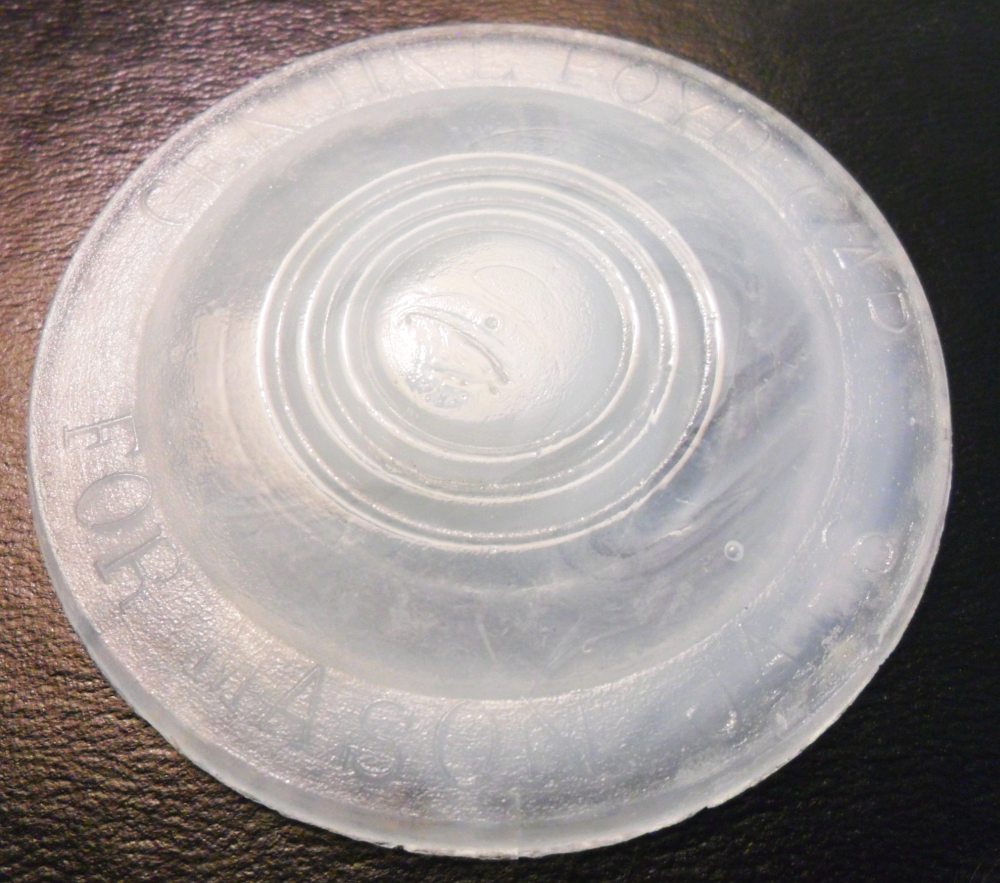
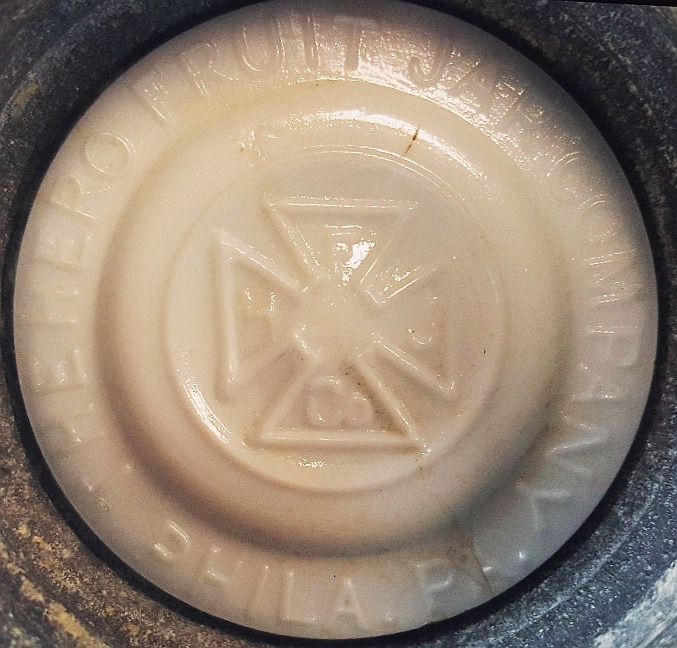
[Added January 24, 2020] Below I am posting photos of an unusual “bulbous” disc seen with the markings “APRIL 2ND 1895” and “PAT. MAY 28TH 1895”. These “immerser lids” were made to accompany certain jars made by Gilchrist Jar Company. (Some jars or discs may have been made by Hazel-Atlas Glass Company). These pics were sent to me by Stacy Rawlings. THANK YOU Stacy! More background info on these jars and the lids can be found at this pdf file article by Bill Lockhart et al: Gilchrist Jar Company
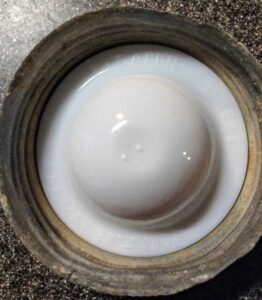

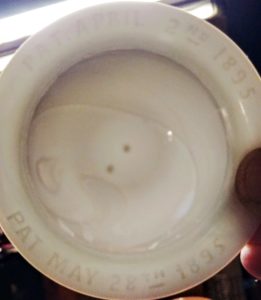
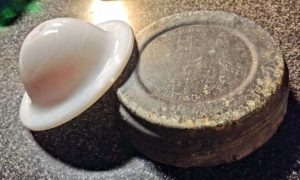

For more information on some of the types of fruit jars involved with the Boyd inserts, see these webpages on the Ball Perfect Mason, and MASON’S PATENT NOV 30TH 1858 Fruit jars.
For an extensive alphabetical list of marks seen on glass bottles, fruit jars, electrical insulators and tableware, please click here to go to the Glass Bottle Marks pages (page one).
Click here for my website Home Page.
ADVERTISEMENT


Found one this week while digging in an older nearly abandoned town in eastern Colorado. Says “Boyd’s genuine porcelain lined cap” does have three circular rings on top. no other markings or numbers.
Hi K. Tate,
Thank you for your comment! I appreciate it! Wouldn’t it be neat to know what kind of preserved food was in the canning jar that used to be attached to? Take care~
David
I found one fishing in the Cuyahoga River in Cleveland, Oh….BOYD’S GENUINE PORCELAIN LINED CAP 300…GARY TOMOTCHKO
I have found several clear glass inserts, a few have presto and a few have the word Harvest. I would appreciate any info.
Just found a Boyd’s Genuine Porcelain Lined Cap. Mine has a distinct 5 in the middle.
I found one too! Digging next to the foundation of my 200 yr old house for post holes. So I was a good bit down, house was built in 1887. It says boyds genuine porcelain – but spelled wrong – cap, and there is a #1 in the middle of the circles!
Found one today with Boyd’s Genuine Porcelain Lined Cap at the American Fall’s, Idaho river they are draining. It was where the old town was before they moved it. Really cool find.
I found one Wednesday Nov 9th while metal detecting a small park in north Idaho. It’s milk glass says Boyd’s genuine porcelain lined cap, no other markings … cool find though was thinking jar full of old gold and silver below it but NOT…
Hi Richard,
Thanks for your post!! Hard to know exactly why the cap was there, but maybe someone had brought a Mason jar with some kind of beverage in it to a picnic (many years ago) and the lid was thrown away or lost. Or there used to be a casual dumpsite in that area?
That’s definitely a better find than a nail, a bottle cap or an aluminum pull tab!
Take care,
David
I found one in an old cellar of an old house from the 1950s at least.
I found four in a creek down by my house
I found one today while metal detecting with my XP Deus 1 about 9” deep. Luckily part of the zinc screw on lid was on it, I’m so glad I didn’t hit it with my shovel. I found it behind my house here in Bokoshe Oklahoma.
Archaeologist here, working on a collection of artifacts from Knoxville, TN. Just ran across some wording on a Boyd’s liner: “BOYD’S GENUINE PORCELAIN LINED” with no use of the word “CAP.” It is made of translucent white milk glass.
CFH,
Thank you very much for the info. I am assuming the liner you found does NOT have the “M inside a diamond” in the center, correct? I’m only asking that because of one of the variants noted in my list on the page. I want to make sure the one you are documenting is definitely another variant.
Take care,
David
I just found a Boyd’s cap in upstate New York. Originally I thought that it was a cap to a small white jar that I dug up next to it but it wasn’t a clear fit. The jar still had some sort of paste in it! Pretty cool to now know what the white disks purpose was. Thank you
Hi Brianna,
Thanks for your post! Those Boyd’s discs can show up just about anywhere! Take care,
David
I dug up a Boyd’s lid with 25 8 and a cockeyed H on the rim of the porcelain.
It has all of the usual words. “Boyd’s Genuine Porcelain Lined Cap” and then those that I mentioned.
Any idea on this one???
I found one with a 24 instead of 25. Wish I knew more.
Tom, many different mold numbers are found on the Boyd’s milk glass liners. The mold numbers don’t “mean anything” other than identifying the mold a particular liner was produced from. The molds were engraved with different numbers to identify each one, and to easily pinpoint the specific mold if there were any problems with the finished glass product coming from that mold (in this case – jar liners).
Best regards,
David
I found one of these little kiddie dishes on the surface of an area I suspected to be a dumping ground back in the late 1800s. It says “The Hero Fruit Jar Company Phila Pa” with the Maltese cross in the center. Thanks to this page I know what I have.
Hi Ed,
Thank you for your post! Your “kiddie dish” quote made me think that it’s very possible some of these have been used, at some time or other in the past, as miniature plates or saucers – by girls playing with their dollhouses!
~ David
Thank you! I found one of these when sea glass hunting in Maine. It’s only slightly damaged and is a fun piece to have, especially now that I know what it was used for!
Thank you for this site!!! My 88 year old mother gave me her mother’s Ball jars, with the original tin and milk glass lids this past weekend. Thanks to you, I now know what these are made of. Happy Holidays!
Thank you Sherri! Happy Holidays to you as well!
~David
we found two of these together in the dirt yesterday one is plain white with no markings and one says Boyd’s genuine porcelain lined cap no numbers or anything Marion Ohio
I found one with all of the words backwards. The letters were the right way except the B and the E’s. It said Boyd’s Genuine Porcelain lined cap ok1 28
I dig these often metal detecting,i dug one yesterday that has letters missing in the spelling around it,they aren’t scratched off they were never stamped or molded on it.
Dean Schwab 4/22/19 …… While Metal Detecting in a small park circa 1910 at Metaline Falls Wa. State. Found buried 5″ deep a Tin Screw Lid with a white insert. Went home and when cleaned, stated ” Boyds Genuine Porcelain Lined Cap”
Found your site after a Google Search and Wallah here we are.
Thank You… Your site was a Big Help…. Dean’o
I’m from Birmingham Alabama and a few days ago I found one that’s milky white but doesn’t have any letter or number in the middle, it only says Genuine Boyd Cap for Mason Jars.
Howdy! We are clearing a ten acre field, mostly covered in trees, in South, Sourh Dallas to build a car dealership and I found a white “BOYD’S GENUINE PORCELAIN LINED” cap with the N’s backwards and a 3 on the back. It is not hand stamped. I had no idea what it was. Thank you for being here.
Greg, thank you for the post! Glad to be of some help in identifying your find!
~David
Today I found a Genuine Boyd’s porcelain cap, white milk glass porcelain liner with a “5” in the center circle , in Marshfield, Missouri. Most of the zinc lid was still intact.
I just found a Genuine Boyd Cap For Mason Jars lid here in the woods on the South Oregon Coast. It has the three circles in the middle, and it has a lovely iridescence all around the edges.
I had never heard of them, so your site was the second treasure I found today.
I found a zinc/milk glass top that fits the variation #3 you listed above, I know it’s hard to date these items but is there a roundabout time frame for this particular piece?
Danielle,
I’m sorry but all the info I currently have is here on this webpage. The milk glass discs are very hard (i.e. almost impossible) to date exactly. As far as I know, there is no other webpage on the internet (and no books, magazine articles, etc) available that even discusses this item in a specific way. I created this page in an effort to gather more meaningful data on them, since some glass collectors do save them, albeit in a very casual, “non-collecting” way. A lot of the background info on how old particular discs are may never be discovered. I would say just ‘enjoy the variations’. 🙂
Take care, David
Found one today. Several old homesites on my property. Find all sorts of glass… Bits of crocks or dishes washed down the creek. The stamping on this one may be hand done. Letter spacing is off or letters at the wrong angle. Stamped Genuine Boyd cap for Mason jars. Thanks to this site I now know what it is I found.
I’m from middle TN and while metal detecting in my woods, I found a Boyd’s Genuine Porcelain Lined Cap in great condition with a letter M.
https://i.imgur.com/xVlNRuh.jpg
Do you still have this insert?
I just found a Boyd’s Genuine Porcelain Lined Cap with what appears to be a J in the center of the lid
Hawkeye,
That’s a milkglass insert from the “Marion Jar” or one of the other types of jars made by the Marion Fruit Jar and Bottle Company of Marion, IN. See the listing for “M in a diamond” on this page: https://glassbottlemarks.com/bottlemarks-4/
Best regards, David
I found one while digging in my back yard in Fairmont WV it is marked with a 4in the center. It is milk colored glass has a seal ring and a metal piece in the center on bottom which broke when washing it off. Was just curios of how old it may be.
Anita, I don’t have information that would reveal how old any particular disc is.
David
Hey I recently found one in south Carolina while weedeating a ditch out… looks fairly old… This one states “Genuine Boyd Cap / For Mason Jars” stamped with a 22 my email is nockbrooks059@gmail.com if you can tell me any information on it let me know. This one is in great condition.
Has a H and an A stamped in the middle.
Hi, I have a pickle pusher insert without the zink lid, and an old zink lid without its porcelain insert. Can I join these two together to make a complete lid. Im not sure how to go about it. I don’t want to damage the pickle pusher. Thank you😊
Can an insert be put in a zink lid that’s missing or has a damaged insert
Tami, I have never tried it, but it seems as if it might either damage the lid, or break the insert, or both.
best regards,
David
Thank you. For some reason I couldn’t find this question and response on this forum. I thought maybe it didn’t go through. I re ask the question again, please dissreguard.
I recently found a canning jar lid under a home built in the 1890’s, I have seen, and found the ones made out of milk glass before in PA. The one I just found is made of clear glass and has no visible markings on it. Can anyone please help me get at least an approximate date to it?
Jennifer, can you email me with a picture of the lid? Thanks,
David
I found a porcelain jar cap. It had the the words: Genuine Porcelain Lined Mason Cap printed on top. It had the number 36 in center of the small raised dome. About 2 inches or so across. Do you know anything about this? Thanks!
Hi Lois, The ’36’ is a mold number. Hard to say who manufactured it, or just how old it is, since they were made for a long period of time by several glass companies. I wish had more detailed info for you, but that’s the best I can do.
Take care,
David
Just found an opaque white insert on my property in rural, western Oregon. It says Boyd’s Porcelain Lined and has two small boxes that have two small matching symbols that look like a box where the lines extend past the box to make and X. I think my dogs dug it up because it was sitting on a gravel path to our pasture that we have walked on hundreds of times and just saw it today. Very cool to learn about our little find. Thanks for your website. Very informative. And I will definitely be keeping it. I love history and love that I found a piece of it on my land!
Found a milk glass liner without lid while creeking today in SE Ohio. The lettering is as follows: GENUINE BOYD’S CAP FOR MASON JAR (small D9) with Hazel-Atlas makers mark in the middle and no other markings. Creek is locates just a little south of Zanesville OH where there used to be a manufacturing plat located. The marking for Zanesville is a K, however there is not K or any other location letter on this liner. It has been fun learning about the liners over the last hour and a half. Now that I know what they are I’m sure I will start seeing them every where I go. 🙂
I’m no expert, but I had a friend that used wax instead of inserts.
I’ve found six of these now, and only one of them porcelain. the porcelain one has a number 6 in the middle and says boyds genuine porcelain lined cap. of the other five, only two are the slightly the same, made of milk glass and say genuine boyd’s cap for mason jar and have a hazel-atlas symbol in the middle. however, the mold numbers and word placement differ. one of the others say genuine zinc cap for ball mason jars and diamonds in the middle of the words. one other says genuine boyd’s cap for mason jars with nothing except for more rings in the middle. the last says genuine boyd cap for mason jars and is somewhat crude. is it possible to date any of these?
Collin,
In my opinion (and that is just an opinion), it is very difficult to date any of these discs. Only a very general time range can be given for most of them at the present time.
David
Ok thanks David!
I am a trustee at a local glass museum and have been asked to give a talk on canning jars. I am puzzled by two known patent dates regarding the porcelain lined lid. If John Landis Mason patented the threaded canning jar lid in 1858 and Lewis R. Boyd received a patent for his glass insert in 1869, then what was used to line the lids prior to the availability of Boyd’s glass insert?
Hi Richard,
Very good question……. but from information on pages 127-128 of “The Fruit Jar Works, Volume 1” by Alice Creswick, the so-called “Crowleytown” Mason jars are believed to be the first with the Nov 30th 1858 marking, and are believed to have come with unlined zinc lids — those lids may be found marked with the patent dates “June 2 1857” or “Oct. 27 1857”. There may or may not have been any type of glass “barrier” next to the bare metal of the earliest lids used (??). If used, presumably they were plain unmarked aqua glass discs of some sort. Perhaps a more knowledgable specialist/ collector of those early jars can contribute information here!
~David
I recently found a milky white glass cap in my yard. It says, “Boyd’s Genuine Porcelain Lined Cap.” It has 3 rings and a “4” in the center. Also found an old clear glass bottle with the word Confair’s on the side and Berwick, PA on the bottom. Could you give me any information on it? Thank you!
Dawn, I don’t know anything about the Confair’s Berwick PA bottle. Maybe a reader will have more information.
Take care, David
I would like to share some information on a cap that I just found. We purchased an old farmhouse dating back to the early 1800’s near Philadelphia, PA. While moving some plants with a backhoe I uncovered a lid. It states “Boyds Genuine Porcelain Lined”. It is a milky white to clear lid, but the interesting item about this lid is that it has an iron cross in the middle. Has anyone ever come across this marking and does anyone have any information on this marking and why it was put there? Thanks, Mike
Mike, I think the milkglass disc you found is a type used with fruit jar screw-type zinc lids for the Hero Fruit Jar Company fruit jars marked “MASON’S [cross] PATENT NOV. 30TH 1858” on the front. (There are several variations of those jars.) The ‘cross’ logo may or may not have the letters “H F J Co”, with a letter arranged in each “arm” of the cross. Sometimes the lettering is very faint. Hero Fruit Jar Company was in business from around 1883 to circa 1909, based in Philadelphia, PA. Other glass companies also made jars for Hero, including Marion Fruit Jar and Bottle Company, Marion, IN, and Cumberland Glass Manufacturing Company, Bridgeton, NJ.
~David
Since June 1960 my family lived in a place that was originally a wheat field farmed in the early 1900’s of Tulare County California USA. The house I grew up in was built in 1910, and a well was dug, last year the drought in California caused us to build a new drilled well, when cleaning up the old well was a trash sight several bottles and the Boyd’s Porcelain Lined Cap was found greenish in color, and a lid with no markings white both in good condition.
I live in Boonville Indiana. After living on our property for 23 years we found a place where there is glass bottles buried. I found 16 beautiful bottles in just a short time and can’t wait to find more. I found a white lid Genuine Boyd Cap For Mason Jars, Ns are backward. Hopefully I found some old pieces. Linda
Thank you for your post, Linda. Sounds like you found an old trash dumping area, or perhaps where an old outhouse used to be on your property. Good luck on finding lots of old goodies!
David
I just found one while walking along a creek in east Texas. Opaque white glass, says “Boyd’s Porcelain Lined”, and the “D” in Lined is backwards. Wondering about it led me to this site, thanks for having info available here!
I found one of these while metal detecting along the Hudson River in upstate New York. The one I found has an 8 in the center, double and triple checked and its not a 3. Can you tell me anything about it. Thank you
I just found one in the bottom of the Driftwood River in Columbus Indiana. It says Boyd’s genuine porcelain lined. The interesting thing about this one is the “N” are all backwards. When I first found it I picked it up to see how far I could skip it across the river. I’m glad I didn’t.
Hi John,
Thanks for electing to save it instead of skipping it! I know that occasionally some discs bear mold-tooling errors (such as backward letters or numbers) but I don’t know how common or scarce your variant may be. Nice find!
~David
I just found one exactly the same. Have you found aything more about them. Mine also has a 14 on the opposite side of the boyd with backwards N. I’m guessing it’s a cavity number for the mold but not sure.
My friend and I found four differen inserts, one with a complete cap, along an old mined area creek wash in Newton County Missouri. Never seen them before and love the hisory. I believe ours are all white glass, not porcelain, and all say Boyd or Boyds, so nothing unique. They are pretty cool to come across tho, and I suppose there are probably millions undiscovered as we are a throw away sociey, even then. Love to think of the people working the land and drinking MILK!
Hi Tony,
Thanks for your post! Yes, I would guess that there are untold millions that have been thrown away over the years, although a lot of the inserts are found broken. But, many of them are still around, still inside the zinc lids. Just a thought for you and other readers— If you should ever browse a flea market, antique mall or some such place, and see some of the older aqua or blue canning jars for sale (although usually they are sold without the lids), if you see any with the older style zinc lids still in place, unscrew a lid and check the white milkglass insert inside! On a rare occasion a scarcer type might be found, with a name or logo embossed. Although a lot of the discs bear just mold numbers on the top (and/or sometimes on the bottom).
Take care, David
Thanks. Funny thing as my mom visited her 1948 homestead farm home as a child some years ago in Balaton, MN, along Cottonwood Creek, and ventured into the collapsed house and dirt cellar where she had lived. She found and old Ball quart canning fruit jar half buried in the cellar from my grandma and gave it to me a few years ago. It now holds river stones from my hometown in Worthington, MN. The house and farm are gone now, but after finding the inserts this past weekend, I went to look in the jar i have and sure enough there is an insert inside, never knew, but this one bears no numbers, letters or markings of any kind, and appears to be glass too. It is larger than the milk inserts. Makes it even more interesting to me as its a family thing.”
Tony, thanks for your post! I appreciate the bit of personal history you have passed along! Great story– I wish more people would be more interested in their own family history, where their own family grew up, and things of that nature. It makes our own lives so interesting to have a better idea on knowing what has gone before. Best regards,
David
Yes, three are complete and whole except one one was three broken pieces and I super glued them.
I found an insert that reads “Boyd’s Genuine Porcelain Lined” All the N’s are backwards. What date range would this fall in and is it rare?
Hi Mike, I really can’t say how common this is, or what date range it would fall in. My guess would be it dates before 1920, but that is only a guess.
~David
Mike, there is no way to tell exactly how old any of these discs are. The ‘backward N’ is a mold error and is found occasionally on these discs (and often on other types of antique glassware such as bottles and telegraph insulators). They would be somewhat scarce, but definitely not “rare”. Of course, those terms have different meanings to different people!
~David
Today we were exploring an old family home site. Dates back to 1850-1890’s. Found a boys lid. It reads K2 BOYD’S GENUIN PORCELAIN LINED CAP. Any ideas what the K2 is or why it’s spelled genuin instead of genuine? There is not a space for the E so I know it’s not just worn off. Haven’t been able to find a cap just like this one. Thanks
Hi Craig, this is an example of an embossing error (mold-cutting error). Embossing errors are very common on older glass insulators, and occur on many antique bottles, but I haven’t seen this particular error on a Boyd’s milkglass cap/insert. No ideas on how common or scarce this error may be. The “K2” is probably a mold identifier, identifying the particular mold the insert was made from. There were likely many identical molds being used simultaneously to press out these caps, and each one might have carried a letter, number, or letter/number combo for identification purposes within the factory.
Take care, David
There is a possibility the K stands for Zanesville Oh where it may have been manufactured,
We are currently bulldozing our creek bank to prevent erosion and while doing so, our equipment operator found an old hand-dug well near the creek. My great grandfather purchased this farm in 1882 and I know prior to that date that there was an old house and a well on the bluff near the creek bed. My daddy in 1950 covered up the old well so that no one would fall into it. While bull-dozing the area, we found this well, lined with sand rock and in the well, I found two perfectly round discs that are engraved, Boyd’s Genuine Porcelain Lined Caps along with other interesting metal items such as metal shoes that cobblers used, an old tin pitcher, hoes and rakes. One of the porcelain lids has the numeral 1 in the center of it and the other has the number 4 in the center. Both numbers are embossed in the reverse though. How interesting it is to find such treasures, even tho they may not be worth anything of real value.
Hi Laurie,
How interesting! Thanks a lot for your post! Just curious, what state (or general area) of the US are you in? Sounds like a neat piece of your own family history has been uncovered/re-discovered!! Many people nowadays don’t have much real information on their ancestors or insight into their daily lives, and this is a great example of finding items that have nostalgic value as well as helping shed light on specific people and places in the past.
Take care,
David
Hi David….we are located at Wied, Texas, which is between Shiner (home of Shiner Beer) and Hallettsville, otherwise also known as being south central Texas. I am a real history buff and deeply into my Czech heritage. My great-grandfather, Frantisek Janak and his wife, Rozalie came to America in 1879 with young children. They purchased the farm in 1882 and then it was sold to their son, John August Janak, (my grandfather), who sold it to my dad (John August’s youngest son), in 1953. My parents gift-deeded the 200 acres to me and my three siblings. I have the northern part of the property and Smother’s Creek runs thru the back north-eastern part of the farm. We are bull-dozing down a 50 to 60 foot bluff to prevent erosion and I knew this well was on the property but did not know the exact location, as daddy had marked it further up towards the fence-line in error. I guess he forgot in his later years exactly where the well was after he had covered it up in the 1950s. The milk glass discs are in perfect shape, not cracked or chipped. We will be using a track hoe to dig further down into the well area to see what else we can possible locate. We also found some old medicine bottles and an old Watkins bottle. Wonder what else we will find when we start digging. Thanks for responding to my message. I love these kinds of adventures.
To the moderator–I should have said somewhere that we are in central Arkansas
What fun. Thanks to everyone for these tales. 32 years ago I reclaimed our family’s 1858 log cabin home place along with a beautiful hand dug well that has precise circular stone work all the way down to the waterline. Tonight I was planting a rosemary plant a few feet from the well and came up with very own Boyd’s cap. That well was dug sometime about the time the house was built and there is a large flat stone a few feet away that was the wash stone (I know this from my grandmother). About 15 yards away was a log smoke house that had simi-collapsed when I moved here in 1982. It was where the family had stored their mason canning as well as shoes. Pieces and parts of shoes. Apparently when your bottoms or tops wore out, they were set aside and some part of that might be reused someday. For years every time it rained old shoe parts and canning jars surfaced. I’m sure my ‘porcelain’ top came from that.
Alan, thanks for your post! Interesting stuff!
~David
SORRY AL MY REPLYS ARE AS YOURS , WE ALL NEED TO KNOW THE $ $ $ ON THESE DISKS. JUST A COLLECTOR
Hello Robert,
Sorry, this site is not an appraisal service. My site is primarily about background info on glass making history and provenance, not so much $$$$ value.
However since you are seeking an answer, I will try my best and say that most of them are ‘worth’ maybe 25 cents to a dollar. Some of the more unusual ones might be worth from 1 dollar to 10 dollars. A few extremely scarce ones (and only a very few, experienced, hardcore antique Mason-style jar collectors might be more familiar with what markings appear on the oldest, scarcest examples) might be worth more. If the color of the disc is something other than an ordinary white milkglass, the value will be higher. There are NO SET “MARKET VALUES” for these discs…..and there are NO PRICE GUIDES IN
EXISTENCE!!…………….because they are so common and most collectors who have them are more interested in the fruit jars, but not so much the white discs that are inside the lids. There is no organized
“market” for these items, like there is for antique glass marbles, depression glass, insulators, etc.
However they are OLD and considered COLLECTIBLE. IF you get a dime, 50 cents, or a
dollar apiece at a flea market, consider it a good deal. Best regards and
sorry I cannot answer your question with a “set in stone”, “cut and dried” DEFINITE, CLEAR answer. There IS
NO CLEAR Answer.
Best regards, David
Yesterday, I unearthed a Genuine Boyd’s Cap For Mason Jar with a capital H with lowercase a embossed in the center.
I found it where a draw bridge ( Beaufort NC) was deconstructed earlier this year.
Thanks to you for the great information posted on your site!
Thank you Monica! I appreciate the nice words!
~David
David, I found one of these lids in a creek bed that myself and my dogs go swimming in. Its the one with the crude 3 in the center. How collectable are these and do you know an approximate worth?
They are considered collectible, but most of the ones with the “standard” Boyd phrasing are pretty common. Some of the scarcer types might have more value to someone who actively seeks them out. No comments on “worth” other than “it’s worth whatever an interested collector is willing to pay for it”.
David
I found one in the Platte River in Nebraska….would pioneers starting out on the Oregon trail have had canned foods? It looks like the one on the very top left corner of your collage picture. Is that considered the oldest piece? As I’m looking through my other glass pieces, I have half pieces but only have one intact piece.
Hi Caroline, the inserts have been made since about 1869. (The earliest versions of the so-called “Mason Jar” came into use as far back as 1858). As I’ve written in the text of this page, no one is certain exactly which glass inserts are the oldest, although the oldest ones are believed to have been made in clear or off-clear glass, and the opaque “milk glass” examples were introduced soon after. I have no way of knowing which ones in the group photo are the oldest. I do believe that the lone insert with the mold number “3” in the larger photo may be quite old, but I say that only because of the crudeness of the “3”.
I would imagine the insert you found in the Platte River dates from long after the days of the pioneers, but that would be a question I can’t answer for certain. Most of the inserts are found in areas where trash (including broken jars) were dumped many years ago. Much household trash was dumped along waterways including the banks of creeks, larger streams and rivers, especially in earlier years of this country’s history, when regular trash pickup was still a thing of the future.
~David
I have a porcelain milkglass looking lid with 3/4ths of the zinc cap attached. It is marked “Boyds Genuine Lined Porcelain Cap”. Would it be correct to say it is of the1871 era?
Donna, the “short answer” is NO.
Although I think that some of the older milkglass inserts may have that exact wording (an example is my picture of the “milky foggy” looking piece with the mold number “3” in the center of the top), it is not possible to assign an exact date range to your example. I think that, in general, we can assign a VERY general time period of circa 1880s-1930s for lids with that exact phrase, but this is only a guessing game.
Speaking hypothetically, if an archaeologist was able to (for instance) correlate a considerable quantity of these lids with specific wording to a KNOWN time period, (from a number of a specific type definitely being found within a layer of, for instance, 1880s bottles or 1910s trash deposits), we might potentially get a better idea on tentative answers to this question………however I know of no such study, or of anyone interested in trying to find out which phrases were marked embossed on them during any certain time periods.
Another problem is the fact that since these jars (and lids) were frequently used over very long periods of time, some of the much older lids may be found mixed into trash deposits that are of a much later vintage.
~David
I found one that has a number 4 on it can anybody tell me what year it. Is and how much its worth
Dan, on the Boyd’s milkglass inserts, it’s just a mold number, and gives no information on date.
Sorry, David
I just found one digging a post hole in my son’s back yard, with one has an A with a wide H over it. Have you ever seen one like this. I found a lot on ebay, but not with that symbol. Have any Idea how old it might be.
Hi Patsy,
You have found an insert that was made by Hazel-Atlas Glass Company. Their mark is an “H over a smaller A”. They made lots of milkglass, such as salve, ointment and cold cream jars, small “hen on nest” candy dishes, tableware including vases, compotes and bowls, as well as those little discs for canning jars. For more info on Hazel-Atlas, you can check out my page on that company here. I can’t pin down a specific date for that piece. All we can say for sure is that it dates sometime between 1902 and 1964. However, if I had to make a guess, I would say more likely from the 1920s-1940s.
~David
We found one of these glass liners when we were placing a headstone on a 90 year old grave. Any ideas on how it ended up there? Thank you, Kerry
Hi Kerry,
Interesting~ Here are my thoughts…. You might be surprised how many weird things can show up (almost anywhere) when a little digging is done, even in places where it doesn’t seem to make any sense.
Here goes:
1) Fill dirt. Small amounts of “fill dirt” or topsoil might be occasionally spread around or overlaid on areas within a cemetery, such as to build up and smooth off depressions (formed after long-continued settling of the soil) or to create “new” areas of a cemetery. Occasionally the dirt may have a few artifacts (debris) mixed in, including pieces of old bottles, bits of pottery, broken dishes, pebbles, small chunks of old bricks from construction, etc. Most topsoil is now screened to some extent, but this may not always be the case, especially if it is purchased from an individual or a very casual operation, and was taken from property where old residences or businesses were located (such soil almost always has some pieces of glass in it)…..which leads to my second idea.
2) The cemetery might be located on land that was once an area where a house (or houses) stood. Many years ago, especially before 1900 or so, especially in rural areas, some homes had an area along the back perimeter of the yard where trash was burned or dumped. Sometimes if the back border of a yard is next to an overgrown or wooded area, lots of trash including old glass, etc, would end up there, and as the years passed may eventually be spread out and buried. Also, many homes had an outhouse (privy) into which trash was dumped, and when the outhouse was removed the non-degradable items are still buried in the ground.
3) Someone might have left a fruit jar near the grave as a homemade “vase” with fresh or artificial flowers, or as a memento relating to their love of canning, perhaps containing something inside the jar of special interest. Later, the jar was removed, or damaged by a lawnmower, and the milkglass insert somehow survived destruction.
4) Or maybe the insert itself was left on the grave as a memento for some unknown reason. Does this one have any embossed markings on it?
5) As you know, it’s not unusual for some animals, such as neighborhood dogs, to pick up objects and carry them around. It’s possible a wandering dog picked this up somewhere (maybe 80 or a hundred years ago) and dropped it where it has since lain until you found it!
How’s that for some ideas?? 🙂
Take care, David
Lots of ideas! Thanks! I wanted to think that it was left as a memento for my 2nd great-grandmother who died in 1928. Yes, it says “Boyd’s Genuine Porcelain Cap”. It has a 3 in the middle and on the other side in the middle it has a 2 but it has a more crude look to it.
Thank you Kerry!
how can you separate the glass liner from the lid without breaking the lid?
Hi Cheryl,
From my experience, it seems that most of these milk glass liners (that is, the liner alone) are found in old dumping areas or in a situation where the metal lid had corroded to some extent so that the liner had come loose of it’s own accord. I don’t recommend removing the liner purposely, unless you are perfectly willing to damage the lid. I feel the lid and liner should always be kept intact if it is found in that condition. The entire lid, if in decent condition, will always have more value and (of course) can be of practical use on most typical mason-style jars.
I created this particular page because a lot of these inserts are found individually, i.e. after they have separated from the original lid, and sometimes finders don’t realize what they have found. But I really don’t recommend that you intentionally separate one of them from the lid. But if you do find a “free” insert “as is”, save and display it especially if there are any embossed markings.
Thanks, and have a great day!
David